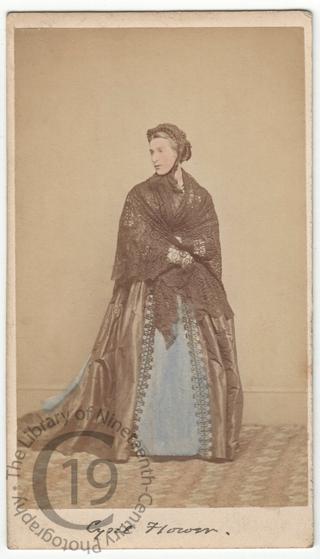
Cyril Flower
A hand-coloured carte-de-visite portrait of the Liberal politician and patron of the arts Cyril Flower (1843-1907), who was raised to the peerage as the 1st Baron Battersea in 1892, taking as his motto Flores curat Deus [English: God cares for the flowers].
The third of eighteen children, he was born at Tooting in 1843. He was educated at Harrow and at Trinity College, Cambridge (BA, 1867, MA 1870). He was called to the Bar at the Inner Temple in 1870 but, like his father, he became involved in property development, and together with his brother, after their father’s death, was responsible for much of the development of Battersea Park Town, as well as the mansion blocks lining the south side of Prince of Wales Drive.
In 1877 he married Constance de Rothschild, the eldest daughter of Sir Anthony Nathan de Rothschild. Aided by his wife’s fortune, in 1880 he entered Parliament as the MP for Brecon, a seat he held until 1885. He then represented Luton until his elevation to the peerage by Gladstone in 1892, serving also as Junior Lord of the Treasury and party whip. He was widely referred as ‘the most handsome man in the House of Commons.’ His charm was also much praised.
His wife’s money enabled him to become a great collector and patron of various artists, among them Sir Edward Burne-Jones, James Whistler, James Tissot, George Watts, Simeon Solomon and John Everett Millais. His bedroom at his London residence was designed and decorated by Carlo Bugatti. In fact, both his homes, Surrey House at Marble Arch and Overstrand, near Cromer, were lavishly and extravagantly decorated. He was also a keen amateur photographer and an all-round sportsman.
He was well-known in society for his love of decoration, not only in his houses but also on his person. In 1898 a Welsh newspaper described him as ‘a gorgeous vision of pale blue, sea-green, or rose-coloured silk.’ The same article reported that ‘in the evening he has been seen resplendent in a ruby velvet dinner suit.’ (South Wales Daily News, 6 December 1898). Another newspaper commented that ‘He is a handsome man, but at times affects costumes which would make him more at home in the pages of Ouida than in scenes of ordinary life’ (Weekly Mail, 21 May 1904).
Ill heath forced his retirement from public life in his later years. Lord Battersea died, aged 64, of pneumonia at the Royal Pier Hotel in Ryde on 27 November 1907. According to a letter published in the Chicago Tribune (4 December 1907): ‘Lord Battersea has for the last few years lived so entirely beyond the ken of society that the demise of this once so popular, handsome, and gifted man has attracted no attention, beyond a quiet expression that his death was a happy release for the kindly and philanthropic woman who had taken his name and given him her fortune.’
Photographed by the Farren Brothers of Cambridge.
This portrait shows him in drag in an amateur production staged at Cambridge during his student days. I’m told he is probably dressed for the part of Mrs Sebright in Tom Taylor’s three-act comedy The Overland Route, a part first created by Mrs Charles Mathews in 1860.
Code: 127445




